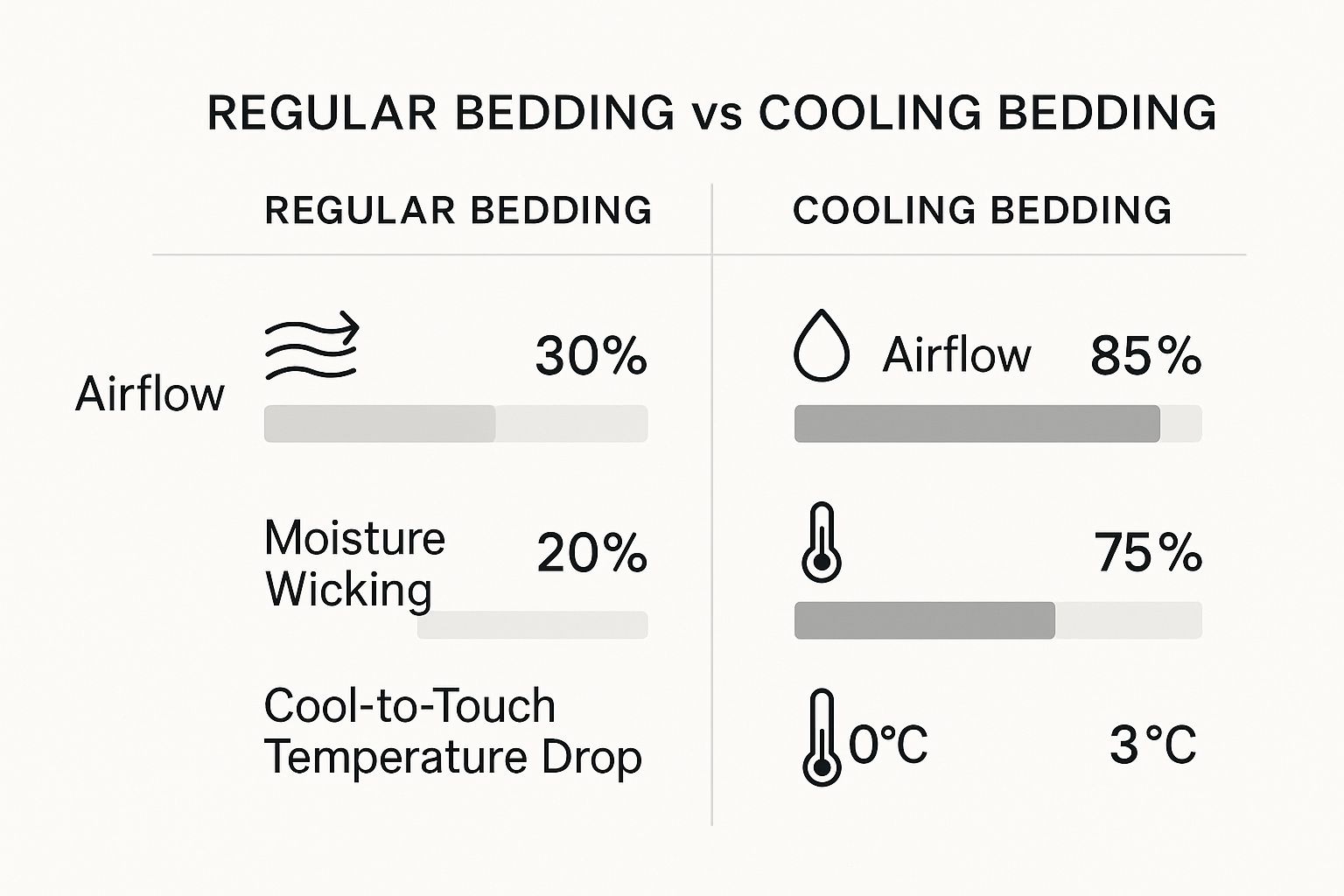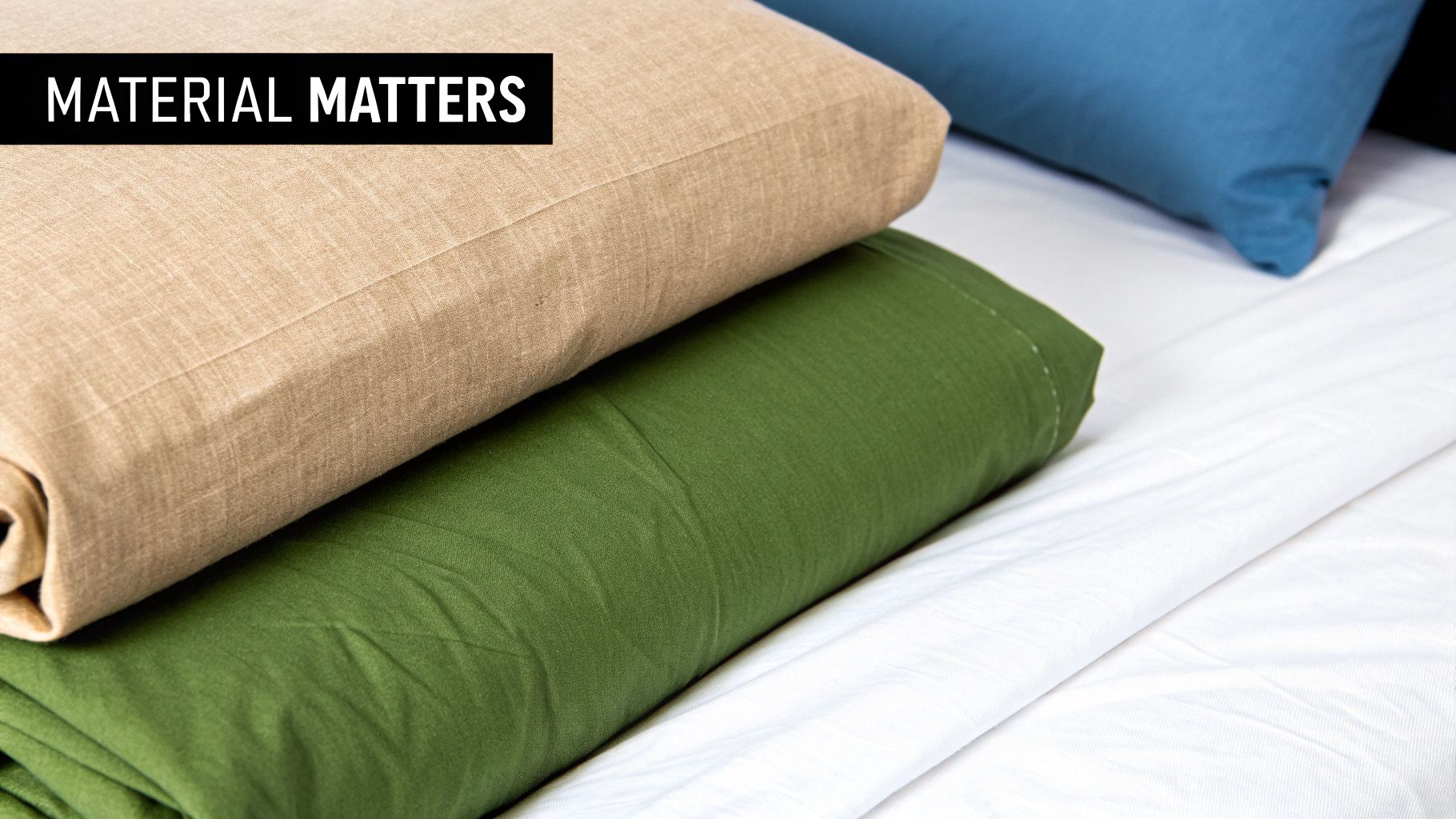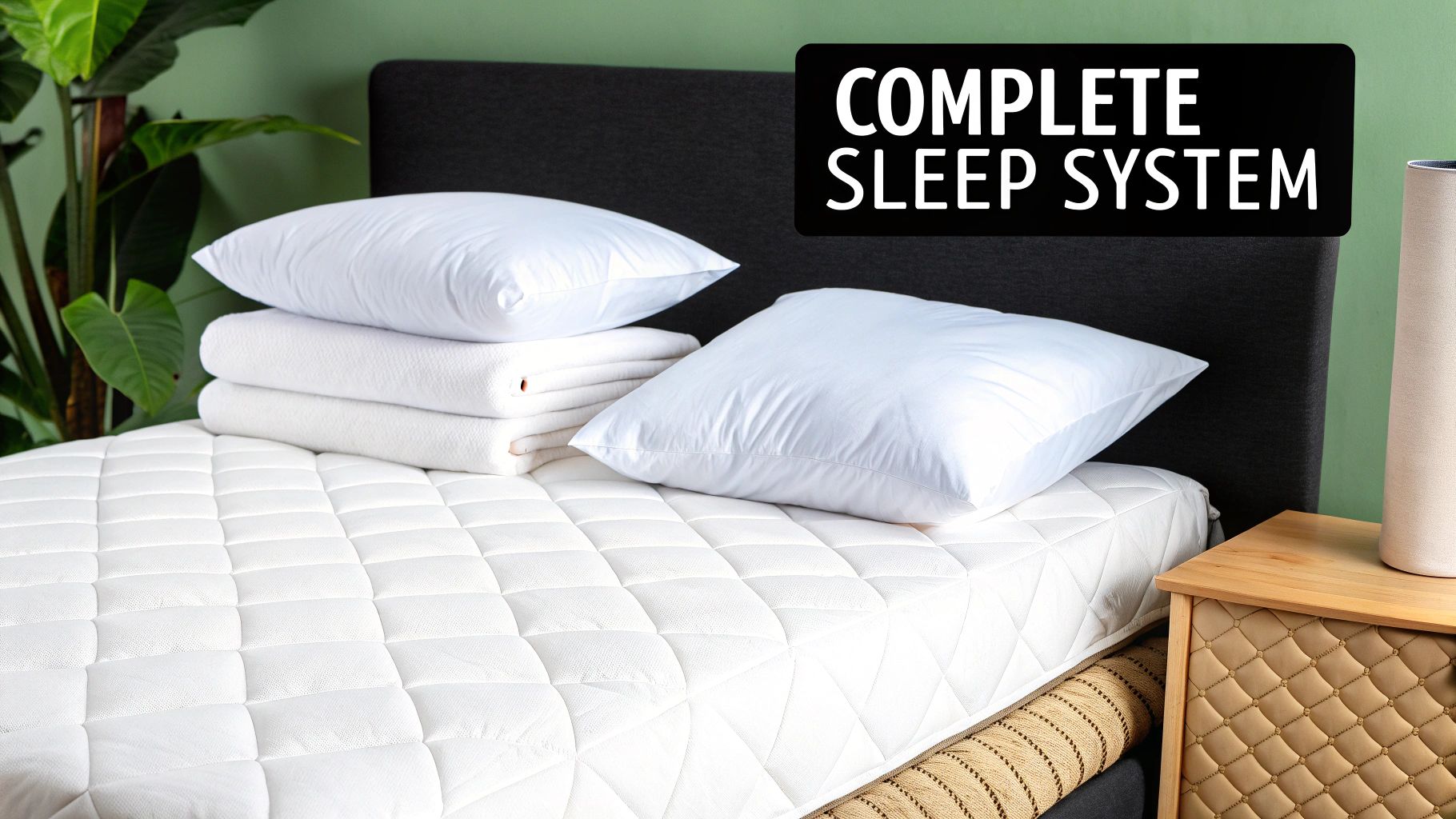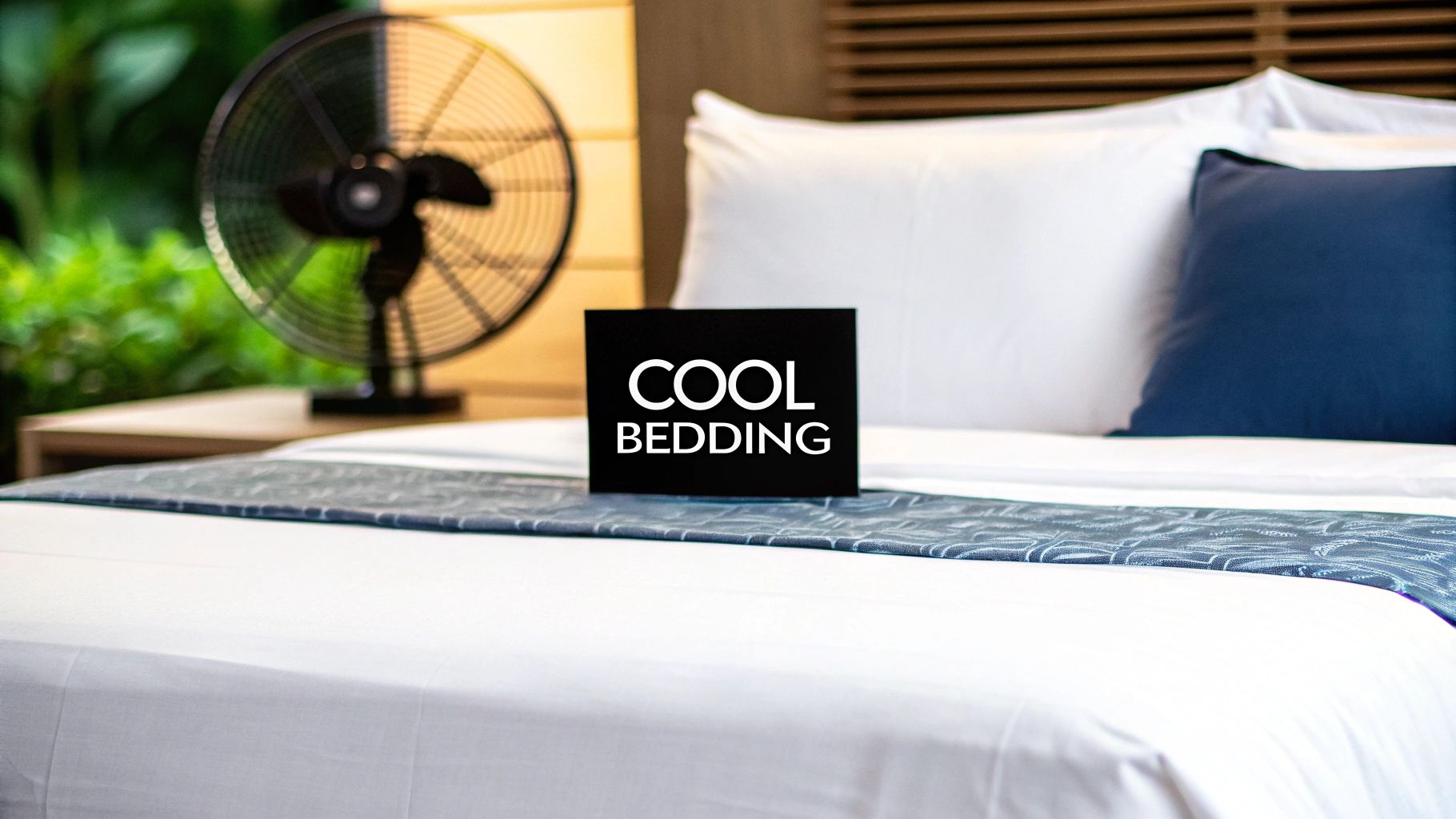If you have ever found yourself tossing and turning on a warm night, kicking off the duvet only to pull it back on an hour later, you are certainly not alone. So many of us struggle with getting too hot in bed, which completely disrupts the deep, restorative sleep our bodies and minds crave. Cooling bedding is designed to solve this exact problem, using clever, breathable fabrics to help regulate your temperature and keep you comfortable all night long.
Why a Cool Bed Is Key to Restful Sleep

Waking up feeling sticky and uncomfortable is a frustratingly common experience. This happens because your body's core temperature actually needs to drop a degree or two to signal that it is time to sleep. When your bedding traps heat, it fights against your body's natural sleep cycle, which almost always leads to a restless night and a groggy morning.
This is a familiar battle for people who naturally sleep hot, but anyone can have their sleep sabotaged by a stuffy bed. The right bedding acts as your personal thermostat, creating a cool, stable environment that helps you drift off faster and, crucially, stay asleep longer.
The Science of Comfortable Sleep
Our bodies are quite brilliant. They run on a natural 24 hour clock, and part of that cycle involves a slight cool down period at bedtime. Think of it as a gentle cue to the brain that it is time to power down for the night. When your bed is too warm, that all important signal gets confused.
This is where the genius of cooling bedding comes into play. Instead of insulating you like a winter coat, these fabrics allow air to move freely and draw heat and moisture away from your body. This simple change helps your body reach that perfect, slightly cooler temperature it needs for high quality rest.
The benefits are immediate and obvious.
- Less Tossing and Turning: When you are not overheating, you are far less likely to wake up and disturb your sleep cycle.
- Deeper, More Restorative Sleep: Maintaining a consistent temperature helps you stay in the most crucial stages of deep sleep for longer.
- A Fresher, Drier Feeling: Moisture wicking materials mean you can say goodbye to that clammy, uncomfortable feeling.
A cooler sleeping environment is not just a luxury, it is fundamental to achieving genuinely restorative sleep. By managing your temperature effectively, you can dramatically improve your sleep quality and wake up feeling properly refreshed.
As we all become more interested in our well being, cooling bedding has grown incredibly popular. Here in the UK, the demand is part of a wider trend of investing in home comfort, with the home bedding market continuing to grow as more of us look for smart, temperature regulating solutions. For more practical advice on improving your rest, you can explore our complete guide on how to sleep better at night.
How Cooling Bedding Actually Works
Ever wondered what makes cooling bedding feel so different from your standard cotton sheets? It is not magic, but clever fabric science designed to tackle overheating from three different angles.
Think of it this way. Some fabrics act like an insulated flask, trapping heat close to your body. Cooling bedding, on the other hand, works more like a breathable mesh, letting that heat escape so you do not wake up in a sweat.
It all boils down to a few key principles that work together to create a more comfortable sleep environment. Once you understand how these features function, you will feel much more confident when choosing the right bedding for your home. It is all about helping your body maintain its ideal temperature for a truly restful night.
The Three Pillars of Cool Sleep
Most cooling bedding relies on a combination of three clever properties. Each one addresses a different aspect of staying comfortable throughout the night, from letting your skin breathe to actively drawing moisture away.
Here is a look at the main technologies that keep you comfortable.
- Superior Breathability: This is the most straightforward principle. Highly breathable fabrics have a looser weave or natural fibres that allow air to circulate freely. This constant airflow prevents warm, stale air from getting trapped around your body, keeping your personal sleep climate fresh.
- Moisture Wicking: Just like your favourite activewear, these fabrics are engineered to pull sweat away from your skin. Instead of absorbing moisture and becoming damp and heavy, the material disperses it across the surface so it can evaporate quickly. The result is you stay feeling dry and fresh all night long.
- Conductive Cooling: Some of the more advanced materials have a high thermal conductivity. This simply means they are excellent at drawing heat away from your body upon contact, creating that noticeable cool to the touch sensation when you first get into bed. It provides instant relief on a warm evening.
This infographic breaks down the difference in performance between standard bedding and specialised cooling bedding.

As you can see, the improvements in airflow and moisture management are significant, directly contributing to a less interrupted, more comfortable night. While sheets are a great start, items like blankets also play a huge role. You can learn more about how different materials are used by exploring the world of cooling blankets for warmer climates.
The goal of cooling bedding is not to make you feel cold, but to help your body maintain a stable, comfortable temperature. It works with your natural sleep cycle, not against it, by removing the excess heat and humidity that so often cause us to wake up.
Exploring The Best Cooling Bedding Materials

Choosing the right material is the single most important decision you will make on your quest for a cooler night's sleep. While dozens of fabrics claim to keep you comfortable, they all feel and perform quite differently. Understanding these nuances is the key to finding the perfect match for your own preferences.
Let's move beyond the jargon and talk about what these materials actually feel like and what makes them work. It is about connecting the science of a fabric to that real life feeling of slipping into a fresh, inviting bed after a long day. From the crisp rustle of natural fibres to the silky glide of modern textiles, there is a cooling solution out there for everyone.
Classic Natural Fibres
For centuries, natural materials have been the cornerstone of comfortable bedding, and for good reason. They are often naturally breathable and durable, offering a time tested route to a more refreshing sleep.
Cotton Percale
If you dream of that crisp, cool sensation of high end hotel sheets, then cotton percale is what you are looking for. Its signature tight, flat weave creates a smooth, matte finish that feels wonderfully fresh against the skin. Unlike its heavier cousin, sateen, percale's structure allows air to circulate freely, which is why it feels so brilliantly light and airy.
Linen
Linen is the undisputed champion of summer comfort. It is spun from the fibres of the flax plant, which are naturally hollow, allowing for incredible airflow and breathability. It is also fantastic at wicking away moisture and, believe it or not, it actually gets softer with every wash. Linen has that distinct, slightly textured feel that is both relaxed and effortlessly stylish, a perfect choice for a casual yet elegant bedroom.
Modern And Innovative Fabrics
Alongside these traditional favourites, modern textile technology has introduced some truly brilliant options. These materials are often engineered specifically to tackle heat and moisture, delivering seriously impressive performance.
Bamboo
Often sold as bamboo viscose or rayon, this fabric is celebrated for its exceptional softness and silky feel. Many people compare it to high end cottons like Egyptian, but with some added perks. Bamboo fabric is incredibly breathable and is known to absorb moisture far more effectively than cotton, pulling it away from your skin to keep you dry all night. It also has a beautiful, fluid drape that looks simply lovely on the bed.
The right material does more than just cool you down; it transforms the entire feel of your bed. The goal is to create a personal sanctuary that feels fresh, clean, and incredibly inviting, night after night.
Tencel™ Lyocell
Tencel™ is a brand name for a type of lyocell, a remarkable fabric made from sustainably sourced wood pulp, usually from eucalyptus trees. It is famous for its impossibly smooth, soft texture and its powerful moisture wicking capabilities. Tencel™ is also naturally hypoallergenic and very gentle on sensitive skin, making it a fantastic all round choice. Its fibres are designed to absorb moisture deep within their core and then release it away from the body, actively supporting your body's natural temperature regulation.
A Quick Comparison of Cooling Bedding Materials
To help you get a clearer picture of how these materials stack up against one another, this quick glance table highlights their key features.
| Material | Best For | Feel | Moisture Wicking |
|---|---|---|---|
| Cotton Percale | Those who love a crisp, "freshly made bed" feeling. | Crisp, light, and matte. | Moderate |
| Linen | A relaxed, natural aesthetic and ultimate breathability. | Textured, airy, and gets softer over time. | High |
| Bamboo | Sleepers wanting a silky soft, smooth as butter feel. | Silky, smooth, and drapes beautifully. | Very High |
| Tencel™ Lyocell | Hot sleepers with sensitive skin seeking a premium feel. | Exceptionally smooth, soft, and cool to the touch. | Excellent |
This table should give you a great starting point, but every sleeper is different. For a more detailed breakdown, our guide to the best material for bed sheets offers an even deeper dive to help you decide.
Ultimately, choosing your cooling bedding material is a personal decision based on what feels best against your skin. Whether you prefer the timeless crispness of cotton percale or the modern, silky touch of Tencel™, finding the right fabric will make a world of difference to your sleep quality. It is a worthwhile investment in your comfort and well being.
Building Your Complete Cooling Sleep System

While choosing the right sheets and duvet cover is a brilliant first step, getting a truly cool night’s sleep is about building a complete system. Think of it like dressing in layers for a chilly day, every single piece has a job. If one of those layers, say your mattress protector, is trapping heat, it completely undermines the good work of your breathable outer layers.
To turn your bed into a proper cool sanctuary, every component needs to play for the same team. This means looking beyond just your sheets to what lies both beneath and above them. When you take a holistic view of your bedding, you create an environment where air can move freely from top to bottom, keeping you comfortable all night.
Start with a Breathable Foundation
The layer closest to your body is often an overlooked heat trap. So many standard mattress protectors are made from synthetic, waterproof materials that essentially act like a plastic sheet, locking in heat and moisture exactly where you do not want it.
A breathable mattress protector can be a complete game changer. Look for options made from materials like Tencel™ or specially designed cotton blends that actively encourage airflow. These protectors give your mattress all the defence it needs without creating a sweaty, uncomfortable barrier, giving your cooling system a strong, airy base to build on.
Choose Your Duvet Wisely
Your duvet is arguably the most critical piece in your temperature regulating puzzle. In the UK, we rate duveys by ‘tog’, which is simply a measure of their thermal insulation. For the warmer months, or for people who just naturally sleep hot, a low tog rating is non negotiable.
- Look for a tog rating between 1.0 and 4.5. These are designed specifically for summer and provide a comforting weight without any heavy insulation.
- Consider the filling. Natural fillings like lightweight down or wool are fantastic for breathability, while many modern microfibre alternatives are engineered for excellent airflow too.
Your duvet should not feel like a heavy blanket pinning you down. It should be a light, airy covering that drapes over you, letting excess body heat escape with ease.
If you would like to get a better handle on how tog ratings and fillings work together, you can learn more about finding the perfect duvet and pillow set for your personal sleep style.
Do Not Forget Your Pillow
Finally, let's think about where you rest your head. Your head and neck are major hotspots for releasing heat, so a cooling pillow can make a massive difference to your overall comfort.
Materials like gel infused memory foam or natural latex are excellent choices. The gel helps to actively draw heat away from your head, while latex has a naturally open cell structure that promotes continuous airflow. Making the switch can give you that wonderful ‘cool side of the pillow’ feeling, all night long.
How to Choose the Right Cooling Bedding for You
Alright, you have got the theory down, so let's get to the fun part: picking out the perfect cooling bedding for your own bed. Finding what works for you is a personal journey. There is no single ‘best’ option, it all comes down to your unique sleep habits and what you find comfortable.
Thinking through a few key questions will make the whole process a lot simpler. It is about more than just finding the right colour; it is a smart investment in your nightly rest. This little bit of prep work will help you land on a solution that genuinely fits your life, setting you up for countless nights of cool, uninterrupted sleep.
What Kind of Sleeper Are You?
First things first, think about how you actually experience heat at night. Your answer will be the biggest clue as to which level of cooling technology you should be looking at.
- Do you get a bit warm occasionally? If you only really find yourself overheating during the summer, a naturally breathable fabric like crisp cotton percale or airy linen might be all you need.
- Are you a consistently hot sleeper? If you are regularly waking up too warm no matter the season, then you will want to look at high performance fabrics. Materials like bamboo or Tencel™ are probably your best bet, as their serious moisture wicking capabilities will make a real difference.
- Do you experience night sweats? For anyone who struggles with significant overheating and sweating, moisture management is the top priority. You should seek out materials specifically known for their exceptional wicking abilities, like Tencel™, which is engineered to pull moisture away from the body fast.
What is Your Budget?
Cooling bedding comes in at all sorts of price points, so it is a good idea to have a budget in mind before you start browsing. While some of the more advanced materials are a bigger investment upfront, there are fantastic options to suit every wallet.
Just remember, this is something you will be using every single night. Investing in a durable, effective set can pay for itself many times over in better sleep and improved well being for years to come. You do not have to go for the most expensive set on the market; instead, focus on finding the best quality you can comfortably afford within your chosen material type.
Think of your bedding not just as a purchase, but as a long term investment in your health. A good night’s sleep is one of the best things you can do for yourself, and the right bedding is a cornerstone of that experience.
How Does It Feel and How Do You Care For It?
Finally, let’s talk practicalities: the touch and texture of the fabric, and what happens on laundry day. Your personal comfort is what matters most, so make sure you choose a material that feels absolutely wonderful against your skin.
Are you someone who loves the crisp, fresh feel of a classic hotel bed? Or do you prefer the silky, smooth glide of a more luxurious fabric? There is no right answer here, only what you love. It is also wise to check the care instructions before you commit. Some materials, like linen, are incredibly robust and get softer with every wash, while others like bamboo need a gentler touch. Go for something that fits realistically with your lifestyle.
The rise of e-commerce has made tracking down these specialist options easier than ever. While you might have traditionally headed to a department store, online shopping now gives UK customers access to a massive variety of premium cooling bedding. This makes comparing materials and finding exactly what you need a whole lot simpler. You can learn more about the evolving UK home bedding market trends on grandviewresearch.com.
As you weigh your options, do not forget that items like duvets (often called comforters) are a huge piece of the puzzle. To see how they fit into your complete cooling sleep system, you might find our guide on choosing cooling comforters really helpful.
Common Questions About Cooling Bedding
As you start exploring the world of cooling bedding, it is completely normal to have a few questions. We get it. To help you make a choice you feel great about, we have gathered some of the most common queries we hear and answered them in a clear, no nonsense way.
Does Cooling Bedding Really Make a Difference?
Yes, absolutely. Properly designed cooling bedding is not just a marketing gimmick; it is a completely different approach to fabric and construction. The materials are intentionally chosen or engineered to be highly breathable and brilliant at managing moisture, which gives your body a helping hand in regulating its temperature overnight.
Think about it this way. Heavy, dense fabrics trap your body heat, creating a stuffy little bubble under the covers. In contrast, materials like linen, bamboo, and Tencel™ let air move freely. They also pull sweat away from your skin before it has a chance to make you feel clammy and uncomfortable. The result is a much more stable and serene sleeping environment.
Is Cooling Bedding Expensive?
Like any kind of bedding, the price can vary quite a bit. While some of the more advanced technical fabrics come with a higher price tag, there are plenty of fantastic, affordable options that do a brilliant job.
For instance, a good quality cotton percale is naturally breathable and often much easier on the wallet. It is best to view it as an investment in your sleep. When you consider the huge impact quality sleep has on your health and energy levels, it is a purchase that pays you back every single morning.
How Do I Care for My Cooling Bedding to Make It Last?
Looking after your bedding properly is the key to making sure it performs well for years. The golden rule is to always check the care label first, as the ideal method depends entirely on the material.
That said, here are a few general pointers.
- Natural fibres like cotton and linen are usually quite hardy. They can handle a warm wash and often get softer and more inviting with every cycle.
- Modern fabrics like bamboo and Tencel™ are a little more delicate. A cooler, gentler wash is best to protect their fine, smooth fibres.
- Here is a top tip for all cooling fabrics: steer clear of fabric softeners. They can leave a coating on the fibres that clogs them up, reducing their natural ability to wick moisture away.
By following these simple steps, you will keep your cooling bedding fresh, effective, and comfortable for countless nights of deep, restorative sleep.
Ready to transform your sleep? Explore the beautiful and practical bedding collections at Morgan and Reid and discover the perfect foundation for a cooler, more comfortable night’s rest. Find your perfect match at https://www.morganandreid.com.



Share:
What Are Shams in Bedding? Learn How to Style Them Perfectly
Finding the Best Tog for Your Summer Duvet